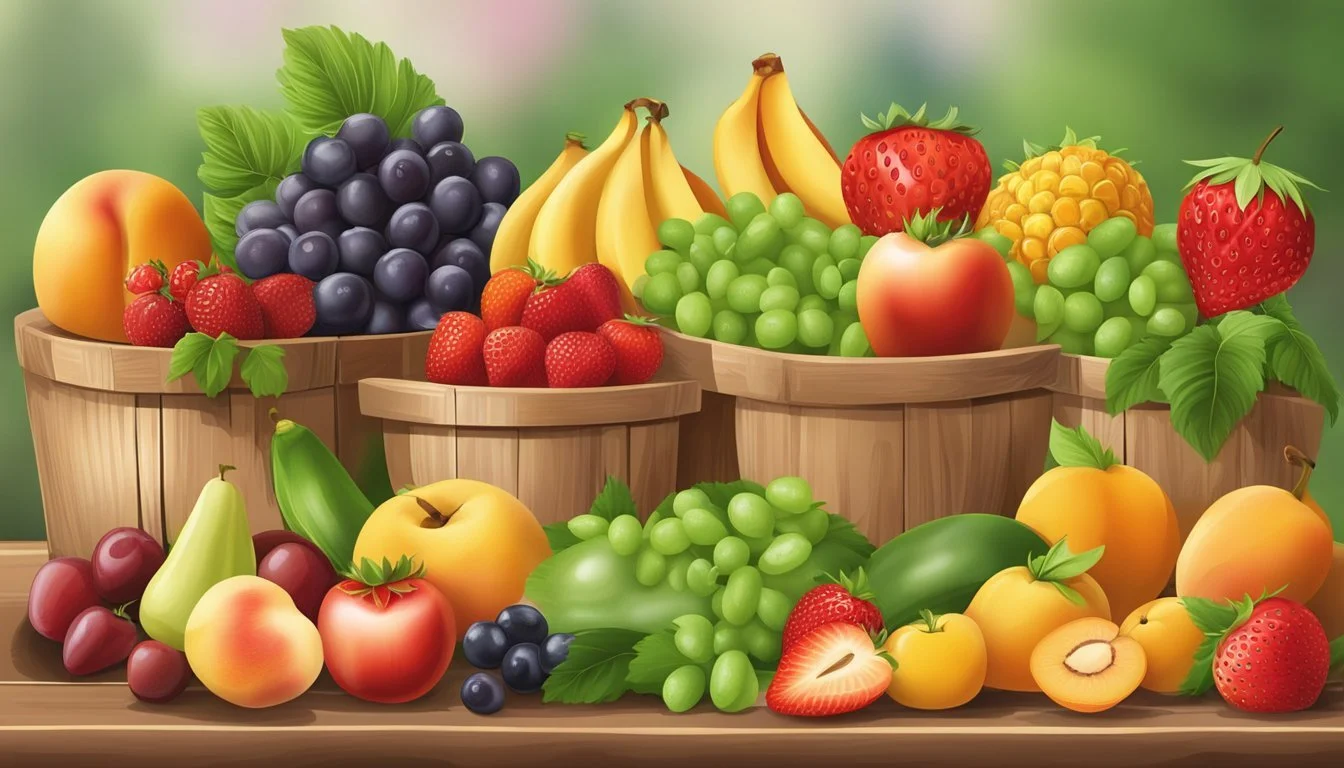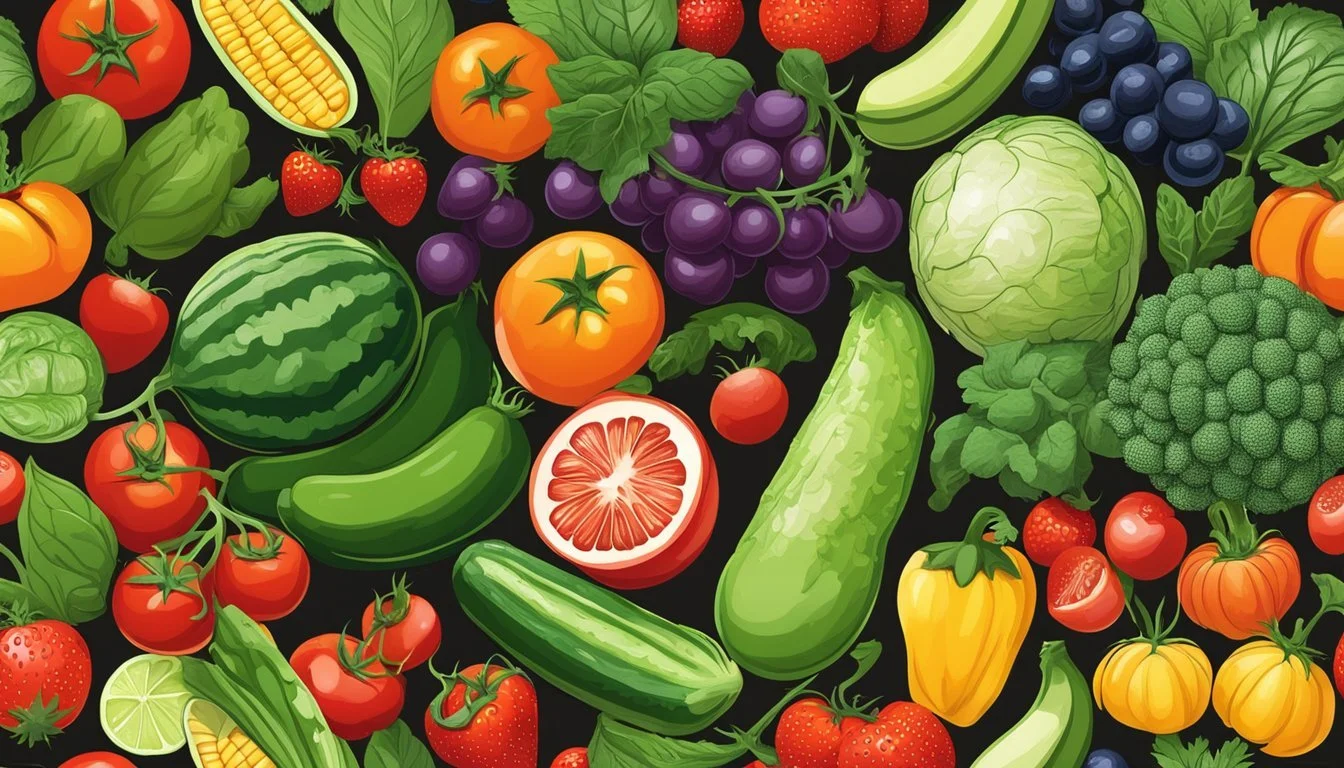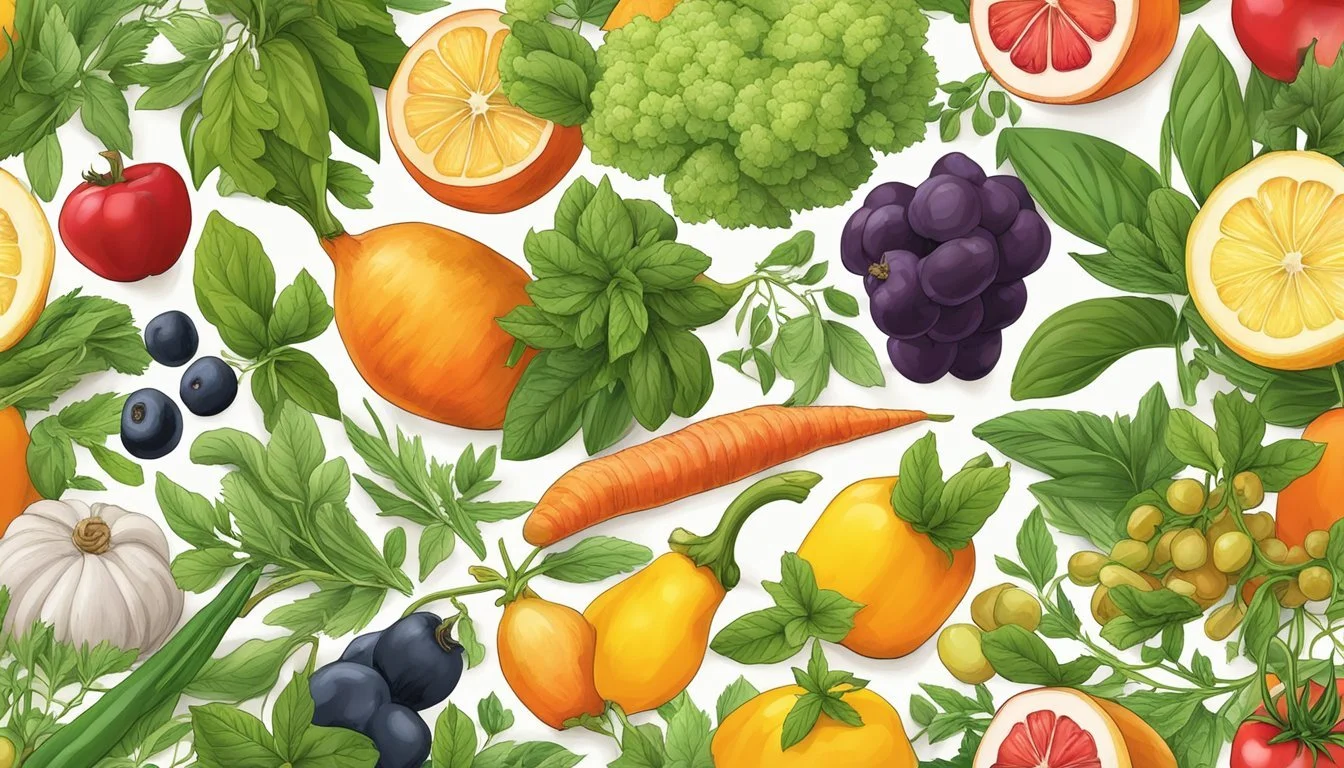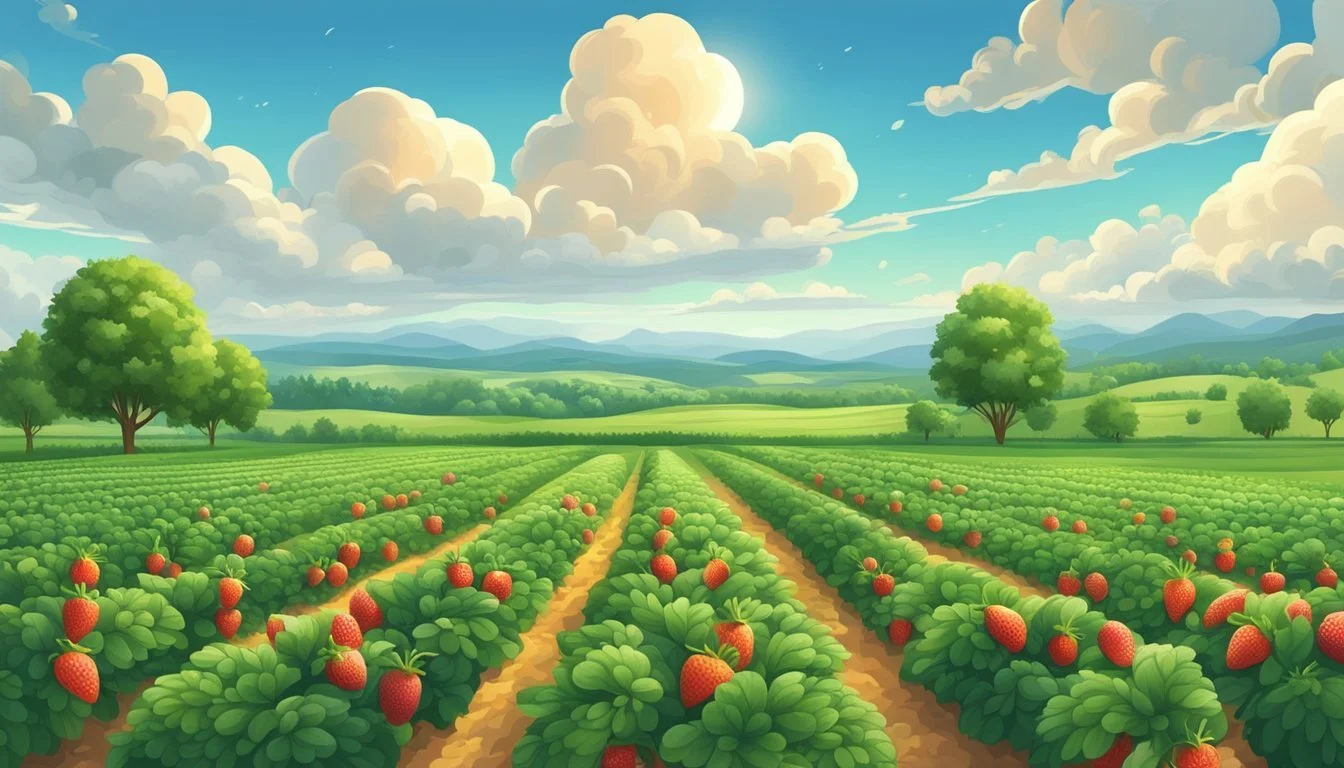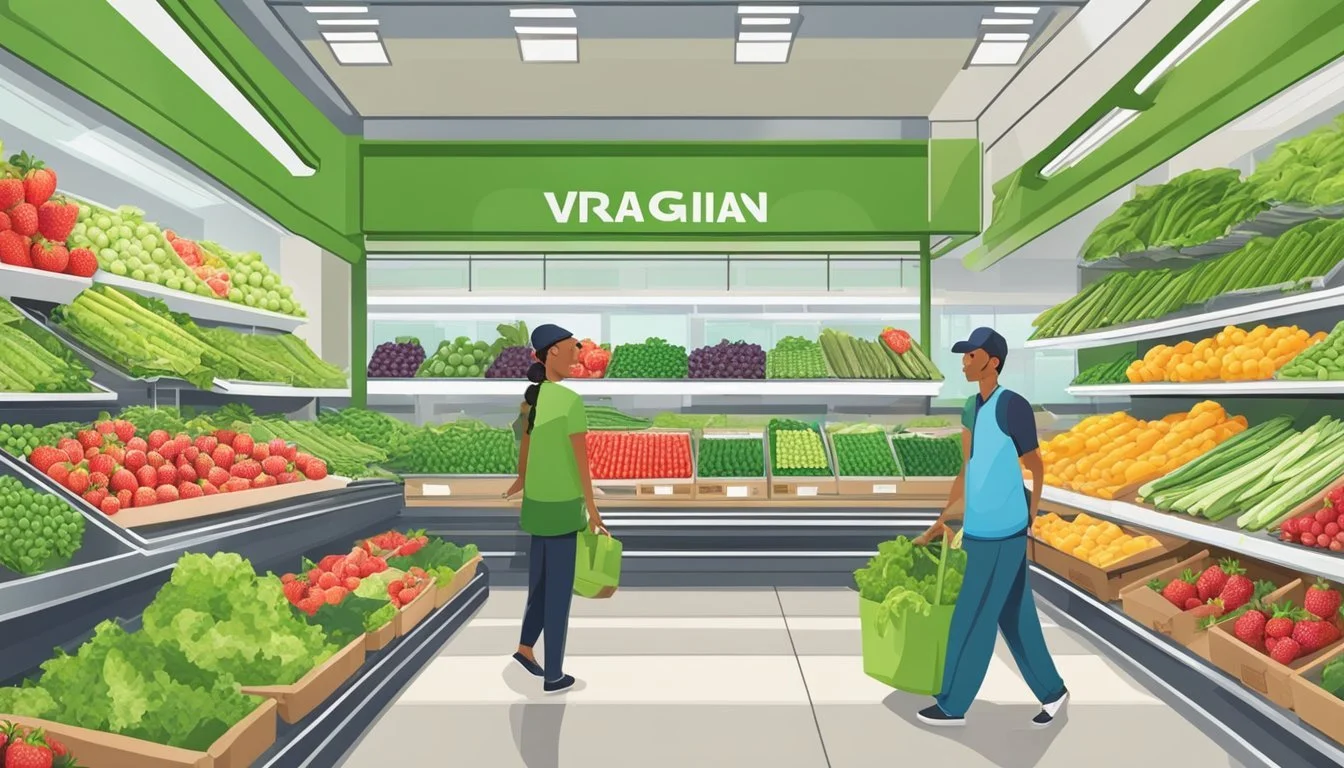Virginia Seasonal Fruit & Vegetables in May
A Guide to Fresh Produce
This Article is Part of our Virginia Seasonal Fruit & Veg Calendar
As spring blossoms in Virginia, the state's agricultural landscape becomes a hub of fresh produce. May marks a transitional period where the last of the cool-weather crops make way for the beginning of summer harvests. Virginians and visitors alike have the opportunity to enjoy a diverse array of fruits and vegetables that are freshly plucked from local farms and gardens.
Seasonal produce not only tastes better, but it also offers ecological and economic benefits, supporting local farming communities and reducing environmental impacts associated with long-distance transportation. During May, Virginia's fields and orchards start to yield a variety of fruits such as strawberries, which become ripe for picking, signaling the sweet onset of the warmer months.
The vegetable selection is equally impressive, with many leafy greens reaching peak freshness. Lettuce, spinach, and kale are commonly harvested in May, offering a wealth of nutrients and flavors for seasonal salads (What wine goes well with salads?). Radishes and asparagus (What wine goes well with asparagus?) continue to be in season, rounding out the medley of vegetables available during this period of abundance in Virginia's agricultural calendar.
Overview of Virginia's Growing Seasons
Virginia's climate and fertile soil make for distinct growing seasons throughout the year. The state experiences four defined seasons:
Spring: As the chill of winter recedes, Virginia welcomes spring with a burst of agricultural activity. Planting begins as early as March and April, setting the stage for a diverse array of produce. Spring ushers in the cultivation of asparagus (how long does asparagus last?), leafy greens, and the tail end of the spring sweet potatoes.
Summer: The warm summer months from June to August are peak times for stone fruits, berries, and a variety of vegetables. Virginia's summer heat is ideal for tomatoes, cucumbers, and corn, among others, which thrive in this period. The state's summer weather contributes to a vibrant and abundant growing season.
Fall: With the arrival of cooler temperatures, fall in Virginia marks the harvest of apples and pumpkins, which are emblematic of the region. This season's moderate climate allows for an extension of many summer crops and welcomes root vegetables like beets (how long do beets last?) and potatoes.
Winter: Winter might signal a slowdown in growing, but it does not bring it to a complete halt. Hardy greens and some root vegetables, such as sweet potatoes, continue to be available. Virginia's relatively mild winters allow growers to extend the season for some crops and even harvest fresh herbs (how long do fresh herbs last?).
The variability and richness of Virginia's growing seasons are a testament to the region's adaptability and the skill of its farmers. Each season brings its own set of crops, aligned with both the weather patterns and regional preferences, shaping Virginia's agricultural landscape.
May's Seasonal Produce Highlights
In May, Virginia's produce selection is robust, offering a variety of fruits and vegetables that are at their peak. Freshness and flavor define this month's bounty, as local markets fill with vibrant produce that signals the heart of spring.
Fruits:
Strawberries: These sweet and succulent berries are a hallmark of May. They can be found in abundance, perfect for eating fresh or incorporating into desserts.
Berries: Following strawberries, other berries start to make their appearance, hinting at the summer fruit season to come.
Vegetables:
Asparagus: Celebrated for its tender stalks, asparagus stands out as a versatile vegetable that can be grilled, roasted, or steamed.
Greens: A variety of leafy greens, including spinach and kale, are widely available and offer a fresh taste of the season.
Availability Table:
Produce Availability Strawberries Peak Season Other Berries Starting Asparagus Peak Season Leafy Greens Abundant
The selection of seasonal and in-season offerings provides consumers with a prime opportunity to enjoy fruits and vegetables that are not only fresh but also have traveled shorter distances to reach the table, supporting local agriculture. Hence, they taste better, offer higher nutritional content, and are typically more economical.
Shoppers during this time can look forward to meals enriched with color and nutrients, direct from Virginia's fields to their plates.
Fruits Available in May
Virginia's mild spring temperatures in May support a variety of fresh fruits that begin to hit their peak. Consumers can enjoy several types of berries that come into season during this month.
Berries in Season
Strawberries: May is an excellent time for strawberries in Virginia, which often become available in the latter half of the month. They are typically ripe for picking and can be found at local markets and pick-your-own farms.
Blueberries: While blueberry season usually starts a bit later in the summer, some early varieties may begin to appear at the end of May, offering a tease of the bountiful blueberry crops to come.
It's important for Virginia residents and visitors to take advantage of these seasonal fruits, as their freshness and flavor are unmatched when harvested at their peak.
Vegetables Peaking in May
As May brings warmer temperatures to Virginia, a variety of vegetables reach their peak, offering freshness and flavor. Gardens and markets teem with vibrant produce ready for the picking.
Leafy Greens Selection
In May, leafy greens such as kale, spinach, and arugula are in abundance, each offering their unique textures and flavors. Lettuce also thrives, with varieties like romaine and leaf lettuce widely available. Locavores rejoice as these greens are perfect for fresh salads and healthy sautés.
Kale: Robust and nutrient-rich, ideal for salads and chips.
Spinach: Tender and versatile, great in both raw and cooked dishes.
Arugula: Peppery flavor, excellent in salads or as a pizza topping.
Lettuce: Crisp and refreshing, a staple for salads and sandwiches.
Cruciferous Vegetables
May is a prime time for cruciferous vegetables such as broccoli. Not only is it packed with vitamins and minerals, but its deep green florets also signify its freshness and taste that can be savored in a multitude of dishes.
Broccoli: Perfect for steaming or adding to stir-fries and salads.
Root Vegetables Variety
Root vegetables like radishes and beets are also peaking. These colorful vegetables add a crisp texture and earthy flavors to any meal. They can be enjoyed raw, roasted, or pickled, providing versatility in culinary use.
Radishes: Crisp and slightly peppery, excellent in salads or as a garnish.
Beets: Sweet and earthy, great when roasted or used in salads.
Other notable vegetables that are in season include asparagus, peas, green onions, and scallions, which can all be found fresh in the month of May. Garlic too, starts to appear in markets, offering its pungent flavor to enhance a wide array of recipes.
Asparagus: Reach for firm stalks for roasting or grilling.
Peas: Sweet and tender, ideal for adding a pop of sweetness to dishes.
Green Onions/Scallions: Mild onion flavor, perfect for garnishes or incorporating into salads and soups.
Garlic: Aromatic and flavorful, a backbone for many savory dishes.
Herbs and Flavor Enhancers
May in Virginia is a peak time for gardeners and chefs to indulge in a variety of fresh herbs. Basil (how long does basil last?), a quintessential herb in Italian cuisine, begins to flourish. It is best used in fresh applications, such as salads or as a finishing touch to pizzas and pastas. Mint, with its refreshing zest, is another herb that thrives during this month. It’s perfect for infusing into teas, cocktails, and desserts.
Sage sees a strong presence in May. Its earthy and slightly peppery flavor makes it an excellent companion for poultry dishes and stuffings. Cilantro (how long does cilantro last?), with its bright and citrus-like undertone, also enjoys the mild climate of May. It's a staple in Mexican and Asian cooking, often sprinkled over dishes just before serving.
Oregano is another herb that reaches its peak. This robust herb, common in Mediterranean dishes, is used to season meats, sauces, and marinades.
Parsley, often regarded for its role as a garnish, should not be underestimated. Both flat-leaf and curly varieties are available, and they lend a fresh, slightly peppery taste to dishes.
Here is a quick reference table for these herbs:
Herb Flavor Profile Common Uses Basil Sweet, peppery Pizzas, salads, pastas Mint Fresh, cool Teas, cocktails, desserts Sage Earthy, peppery Poultry, stuffings Cilantro Bright, citrus-like Topping for various dishes Oregano Robust, aromatic Meats, sauces, marinades Parsley Fresh, slightly peppery Soups, salads, as garnish
Gardeners in Virginia may also grow these herbs for their aromatic properties, which enhance the ambience of their gardens. They understand the value of seasonal planting for both maximizing flavor and ensuring sustainable gardening practices. As a result, May's bounty of herbs contributes to vibrant, flavorful cooking and exemplifies the richness of Virginia’s seasonal produce.
Virginia Markets and Availability
In Virginia, May marks the beginning of a bountiful season for fresh produce. Across the state, markets and farms offer a diverse selection of fruits and vegetables that proclaim the arrival of spring. The region's temperate climate fosters the early harvest of many garden favorites.
Local Farmers' Markets: These vibrant centers bustle with activity, as they become stocked with the freshest local produce. Customers can expect to find seasonal offerings that reflect Virginia's rich agricultural tapestry.
Early Harvests and Their Availability:
Strawberries: A beloved early summer fruit that often makes its first appearance in May.
Asparagus: This perennial is among the first vegetables of the season, with Virginia farms harvesting crisp stalks.
Greens: Including spinach and various lettuces, greens are available and provide a base for spring salads.
Herbs: Aromatic favorites such as mint, basil, and cilantro flourish, enhancing the flavor profile of seasonal dishes.
Radishes: Offering a crisp, peppery flavor, radishes are typically ready for market in May.
Table of May Availability in Virginia:
Produce Availability Strawberries Available Asparagus Available Spinach Available Lettuces Available Mint Available Basil Available Cilantro Available Radishes Available
These products represent only a portion of what Virginia has to offer. With each market visit, consumers delight in the discovery of new arrivals from local farms, ensuring a dynamic and flavorful shopping experience. The state's broad agricultural regions contribute to a robust and varied inventory of produce, ready to be enjoyed by the community.
Impact of Weather on Crop Availability
In Virginia, the month of May is a transitional period where the remnants of spring weather can significantly affect crop availability. The state's growers are well-acquainted with the challenges posed by variable climate conditions. Mild winters can encourage fruit trees to bloom prematurely—a situation that leaves the delicate flowers vulnerable to late frosts. Such frosts can be quite detrimental, leading to a considerable reduction in the yield of certain crops.
For instance, a late hard frost has the potential to wipe out plum crops, as observed in past seasons. Therefore, one may not reliably find local plums in May, should such weather events recur.
Beyond frosts, rainfall levels also influence harvesting timelines and abundance. The spring rains are crucial for the growth of both fruits and vegetables. However, excessive moisture can lead to fungal diseases or compromise the quality of produce.
Regional differences in Virginia's terrain and climate further dictate the seasonal availability of produce. For example, the Heart of Virginia, encompassing areas like Lynchburg and Roanoke, may experience different microclimates affecting the growth cycle of fruits and vegetables in comparison to other regions in the state.
The table below outlines some key crops that one can commonly find in the month of May, provided that weather conditions have been favorable:
Fruit Varieties Vegetable Varieties Strawberries Asparagus Cherries Lettuce Blueberries Spinach Spring Peas
Growers continuously monitor the weather patterns to adjust their planting and harvesting schedules, ensuring a steady supply of produce. Consumers looking to buy local in May should consult updated seasonal calendars or contact local farms for the most current availability information.
Choosing and Storing Fresh Produce
In May, Virginia's markets are abundant with a variety of fresh fruits and vegetables. Consumers should look for vibrant colors and firm textures when selecting produce like asparagus, beets, and strawberries, which are at their peak. These items not only promise the best flavor but also a higher nutrient content.
Asparagus should be bright green with tight, closed tips. They can be kept fresh in the refrigerator — just trim the stems and place them upright in a container with an inch of water. Beets display their freshness through firmness and smooth skin. Store them in the refrigerator, but separate the leaves from the root to preserve freshness.
Strawberries are a favorite in May, and Virginians can enjoy these berries at their most flavorful. Select berries that are fully red without white or green spots. To extend their shelf life, refrigerate the strawberries in a single layer on a paper towel-lined tray, avoiding washing until just before use to prevent mold.
For recipes, asparagus can be a star in light pastas or as a side, roasted with a drizzle of olive oil. Beets can be woven into salads or purées, enhancing dishes with their earthy sweetness. Strawberries can brighten up breakfasts, desserts, or even savory salads.
Lastly, here is a quick guide to storing these May favorites:
Produce Storage Method Expected Shelf Life Asparagus Upright in water, refrigerated 3-4 days Beets In the fridge, leaves removed 7-10 days Strawberries Refrigerated, unwashed, in a single layer 5-7 days
By following these tips, one can ensure their produce maintains its quality and integrates beautifully into a multitude of recipes throughout the season.
Seasonal Recipes and Preparation Tips
In Virginia, May marks the arrival of a vibrant bounty of fresh produce. Home cooks relish this time for the explosion of flavors that can be cultivated from the state's soil.
Fruits: Strawberries take center stage, arriving sweet and ripe. They shine in simple preparations such as fruit salads or can be the star in a classic strawberry shortcake. Citrus fruits, while phasing out, can still add a zesty punch to desserts and marinades.
Vegetables: Cabbage remains crisp and versatile, perfect for a tangy coleslaw or a nutritious stir-fry. Root vegetables like carrots are still abundant. They offer a natural sweetness when roasted or can be shredded raw for a refreshing salad addition.
Herbs: Infuse your dishes with the aromatic presence of fresh herbs like parsley and cilantro, which can elevate even the simplest of recipes with their fresh, green flavor profiles.
Preparation Tips:
Roasting: Enhances natural sugars in root vegetables.
Raw: Sliced or shredded vegetables add crunch to salads.
Sautéing: Quick and healthy for leafy greens.
A well-prepared seasonal dish not only focuses on freshness but also complements the natural flavors of its ingredients. Home chefs are encouraged to experiment with different herbs and spices to discover the perfect melody of tastes that celebrate Virginia's May harvest.



